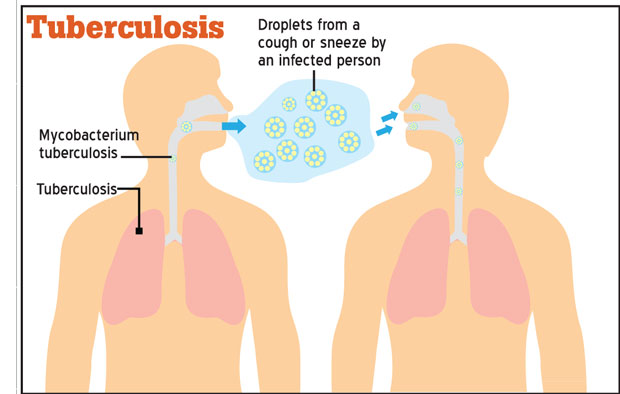Reply To:
Name - Reply Comment
 With ‘Unite to End TB: Leave No One Behind’ being the World Health Organization’s theme for World Tuberculosis Day 2017 scheduled for March 24 every year, it is time that we reflect upon how best we could address the issue of stigma, discrimination and marginalization attached to the disease. According to WHO statistics, 49 million lives were saved from Tuberculosis as a result of effective diagnosis and treatment from 2000-2015. The number of Multi-Drug Resistant patients reported globally in 2015, amounted to 480,000.
With ‘Unite to End TB: Leave No One Behind’ being the World Health Organization’s theme for World Tuberculosis Day 2017 scheduled for March 24 every year, it is time that we reflect upon how best we could address the issue of stigma, discrimination and marginalization attached to the disease. According to WHO statistics, 49 million lives were saved from Tuberculosis as a result of effective diagnosis and treatment from 2000-2015. The number of Multi-Drug Resistant patients reported globally in 2015, amounted to 480,000.
According to the Global Tuberculosis Report 2016 released by the World Health Organization there were an estimated 10.4 million new TB cases identified worldwide in 2015.

An estimated 1.4 million TB deaths were recorded worldwide in the same year. In a candid interview with Health Capsule, Consultant Paediatrician at the Lady Ridgeway Hospital Dr. Deepal Perera enlightened us on how Tuberculosis could jeopardize the health of a person while further explaining on the red flag signs that should be taken to account and the treatment options available to cure the disease.
What is Tuberculosis?
Tuberculosis is a disease caused by a micro bacterium known as Mycobacterium Tuberculosis that affects the lungs of a person with low immunity. It is an airborne disease that spreads through Airborne Droplet Infection. The disease is spread from one adult to another or from an adult to a child. However, the disease can never be spread from a child to an adult. It is a slow-growing bacteria that gradually affects the lungs. It is also a treatable and preventable disease. Tuberculosis is mainly a disease involving the lungs but it can spread to the brain, kidney, bone and other organs as well. As such it is a systematic disease.
Is the disease currently on the rise?
Tuberculosis has been on the rise for the past twenty years. It is a deadly disease. Globally, as the rate of HIV patients increase, the potential for a subsequent increase in the rate of Tuberculosis patients is also very high. This is mainly because HIV patients are prone to contract Tuberculosis. Professor Robert Koch identified the disease and discovered a treatment for Tuberculosis. It is called Koch Disease in the presence of the patient; owing to the stigma attached, but it should also be noted that Tuberculosis is nevertheless a treatable disease.

How exactly can an individual contract the disease and how does the disease affect the lungs of a patient?
Tuberculosis is a contagious disease that could spread from an adult to adult or adult to child. It is an airborne disease. If a patient with Tuberculosis coughs, the tiny saliva droplets could travel through air to the lungs of a healthy person during inhalation; thereby he or she could contract the disease. Tuberculosis could also cause infection in the throat and skin. This is mainly because when the bacteria affect the lungs, through the blood the disease could spread to other parts of the body as well. When the disease affects the lungs we call it as primary disease mainly because the droplets first get deposited in the lungs. In order to react against the bacteria, the lymph nodes in the lungs get enlarged. As a result the patient starts coughing.
What are the symptoms related to the disease?
Patients will experience prolonged cough, continuous fever for more than two weeks, loss of appetite and loss of weight as the initial symptoms. Sometimes, children may experience lymph node enlargement in the neck too.
In the case of adults, they will experience symptoms of secondary tuberculosis. Symptoms may include cavitation of the lungs, chronic cough with blood including poor appetite, fever and loss of weight as in the case of child patients.
Why do patients cough with a spray of blood after contracting Tuberculosis?
Tuberculosis Mycobacterium can invade the blood vessels and arteries in the body. This is the reason why patients cough along with blood after contracting the disease.
This is known as Hemoptysis in medical literature.
What is the difference between Primary and Secondary Tuberculosis?
When the bacteria gets deposited in the lungs for the first time causing the enlargement of lymph nodes, it is known as Primary Tuberculosis. Secondary Tuberculosis occurs when the disease spreads to other parts of the lungs causing cavitation in the lungs. Secondary Tuberculosis could spread to other parts of the body as well.

Are asthma and wheezing health issues linked to Tuberculosis?
Yes, chronic cough could be a symptom related to either wheeze or Tuberculosis. Some patients get treatment for wheeze but in the event a chest x-ray, full blood count and other medical checkups are not conducted properly, it is difficult to identify whether the patient is actually suffering due to wheezing or Tuberculosis.
What are the preventive methods available for Tuberculosis?
Although BCG (Bacillus Calmette–Guérin) vaccination is available from birth it is not hundred percent effective for everyone. BCG vaccination prevents Tuberculosis to a certain level because the efficacy of the treatment may wear off with time. That’s why children are less prone to get Tuberculosis compared to adults. Therefore, although BCG vaccinations are administered to the patient, it cannot be guaranteed that it would act as a proper preventive method against Tuberculosis in the long-term.
What are the treatment options available to cure the disease?
Tuberculosis is mainly a disease involving the lungs but it can spread to the brain, kidney, bone and other organs as well. As it is a systematic disease, treatment should be administered for six months in order to fully cure a patient in the event he or she contracts the disease. Four drugs will be administered during the first two months and two drugs will be given to the patient during the last four months.
If a brain or bone infection is involved, there could be a possibility of developing Meningitis in which case treatment will have to be administered to the patient for another nine to twelve months. Treatment should not be discontinued halfway, as it could result in the patient becoming drug resistant to the disease.
Multidrug-Resistant TB patients are prone to die since they are immune to the treatment generally given to ordinary TB patients. Although BCG (Bacillus Calmette–Guérin) vaccination is available from birth it is not hundred percent effective on everyone. Therefore, although BCG vaccination is administered to the patient it cannot be guaranteed that it would act as a proper preventive method against Tuberculosis. However, it is important to keep in mind that Tuberculosis is a PREVENTABLE and TREATABLE disease and with amply raised awareness among the masses, the disease could be avoided or diagnosed early and treated successfully.
Your feedback is very important to us. We can help you resolve your health concerns and problems. Tell us how we can improve with ideas, suggestions and comments. Your queries on the stories we have found for you are also welcome. Write to us at [email protected]. Let us help you achieve your health & fitness goals with Health Capsule.